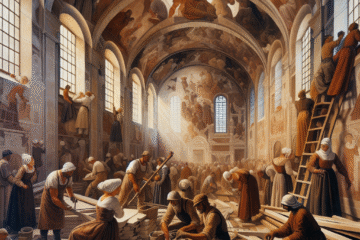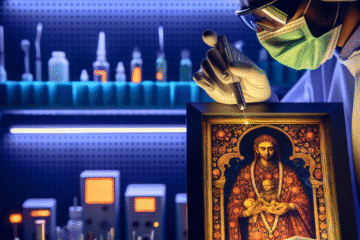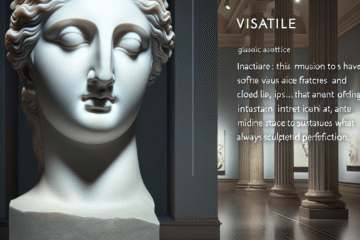
Image title: Hermann von Wedigh III (died 1560)
Medium: Oil and gold on oak
Date: 1532
Source:
The Met Collection
“
To lead people walk behind them.
”
— Laozi
‘Afterlives of Color’: The Global Trade Routes Behind Renaissance Pigments
Introduction: Color as Currency
In the Renaissance world, color was more than a sensory delight—it was a marker of wealth, theology, prestige, and power. The dazzling blues and resplendent reds in masterworks by artists like Titian or Raphael were not mere choices of palette; they were the culmination of perilous journeys, global trade, and cross-cultural exchanges. As Europe emerged from the Middle Ages and stepped into a new, more connected world, pigments like ultramarine from Afghanistan and cochineal red from Mexico transformed the visual language of painting, forging a chromatic legacy that speaks volumes about early globalization.
Chapter 1: Lapis Lazuli and the Sacred Blue of the East
Deep within the rugged mountains of Badakhshan in present-day Afghanistan lay one of the world’s most coveted resources: lapis lazuli. Mined for thousands of years, this gem was painstakingly ground into a radiant pigment known as ultramarine, named for its passage ‘beyond the sea.’ During the Renaissance, ultramarine became the most expensive pigment available to European artists—more precious than gold.
Its costliness gave it symbolic weight. The Virgin Mary, for example, is often depicted draped in robes of ultramarine blue, signifying divinity and heavenly grace. The color linked the sacredness of the subject to the opulence of the medium, a spiritual and monetary investment combined. The sophisticated refining process, involving alum and resin, was passed along trade networks alongside silk and spices, moving from the Silk Road into Venice and beyond—bringing both color and culture.
Chapter 2: Red from the New World—The Rise of Cochineal
While ultramarine flowed into Europe from the East, a different red storm was brewing in the West. When Spanish explorers ventured into present-day Mexico in the early 1500s, they encountered a rich crimson dye made from an insect called cochineal. Indigenous artisans had long cultivated this dye from the prickly pear cactus, creating one of the most vibrant reds the world had ever seen.
The Spanish quickly realized cochineal’s economic potential. By the mid-16th century, it became the second-most valuable import from the Americas after silver. This pigment flooded European markets, transforming the wardrobe of royalty and the canvases of painters. Its vivid hue allowed for subtleties in light, fabric, and flesh that would previously have been impossible. For painters like El Greco and later artists in the Baroque period, cochineal added a previously unimaginable depth to reds—imbuing passion, martyrdom, and royalty with new chromatic resonance.
Chapter 3: Venice and the Transshipment of Color
The city of Venice acted as the beating heart of pigment trade in Europe. As a major Mediterranean port with connections to both Eastern and Western trade routes, it became the essential hub where raw materials were refined, distributed, and transformed into artist-grade pigments. Venetian merchant-artists collaborated with apothecaries and alchemists to enhance preservation and vibrancy of colors—marking one of the earliest known intersections of art and science.
The role of guilds in Venice also cannot be overstated. Color-makers belonged to tightly regulated guilds that protected their recipes and sources fiercely. The materials were not merely bought and sold—they were secretive, cultural artifacts. Knowledge of how to process lapis into usable ultramarine or how to stabilize cochineal onto fabric and canvas became heavily guarded artisanal lore, passed down through generations.
Chapter 4: Color as a Philosopher’s Dream
Beyond the economic and artistic ramifications, the global journey of color also entered the realm of philosophy and aesthetics. The Renaissance was not just rebirth of classical art—it was a reexamination of how humans perceive and represent the world. Color theory had its genesis not just in workshops but in the manuscripts of thinkers like Leon Battista Alberti and Johannes Kepler, who connected color with optics, emotion, and harmony.
Ultramarine and cochineal in particular became symbols of this synthesis. They were both products of empirical pursuit and mystical awe—a tension mirrored in Renaissance efforts to reconcile the spiritual with the scientific. The pigments were materially foreign yet emotionally intimate, steeped in layers of meaning acquired through their long voyages across oceans and deserts.
Chapter 5: The Legacy of Global Pigment Exchanges
The global pigment trade stands as one of the earliest examples of what we might now call globalization—a diffusion of materials, ideas, and aesthetics across vast distances. These colors not only changed the way Europeans painted but also how they perceived the world. Paintings became richer, more emotive, and more spatially complex, reflecting not just technical mastery but interconnected heritage.
Today, the legacy of these pigments continues. Scientific analysis of old masterpieces still uncovers traces of Afghan lapis and Mexican cochineal, reminding us that even the most European of paintings carry within them the dust and dye of faraway lands. They are vibrant relics of global exchange—proof that color, much like art itself, is never isolated but lived, traded, and transformed.
Conclusion: Beyond Borders, Beyond Paint
‘Afterlives of Color’ urges us to reconsider art history not simply as a continuity of styles or movements, but as a shared human narrative carried by ships, camels, and ink-stained hands. Through the remarkable journeys of ultramarine and cochineal, we see not just the triumph of technique, but the unfolding of a connected world—one in which every brushstroke echoes with the footsteps of miners, merchants, and makers across continents.

Image description:
Pigments for sale on market stall, Goa, India.
License:
CC BY 2.0
Source:
Wikimedia Commons
Useful links:


